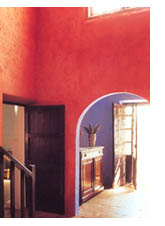| |
One color provides a guide for which other colors blend and complement. Now, we can use the color wheel with some basic color schemes to create your room. First, select the dominant mood you would like for your room, then we will find colors that can be used effectively. Some simple color schemes include:
One color neutral - the easiest color scheme is to select a single neutral color, such as white, cream, or beige, and use it on the walls, floors, ceilings, furniture and accessories. Textures are varied to provide depth and emotion. This produces a very modern, light and airy design, but with the same color on all elements, it can become monotonous over time. Additionally, architectural flaws such as uneven walls or surface imperfections are exaggerated with this monotone paint scheme.
Three of a kind - Using the color wheel, a base color is selected. Two colors that are on either side of the base color are selected to blend with the base color. An example would be red as a base, with red violet and red orange as the analogous colors.
Two complementary colors - Using the color wheel a base color is selected. A single complementary color is selected from a slice of the color wheel opposite to the base color, such as maroon and hunter green. In this color scheme, one of the colors is applied more than the other.

Three colors, Adjacent complements - A variation on the two complementary colors, a base color is first selected on the color wheel and the complementary color slice is found. Instead of using the complementary color, the color on each side of the complement is used.
Four ! - One step farther than the triad, the tetrad combines four colors from the color wheel. On the color wheel, select a base color, and then draw four equally spaced imaginary lines, selecting the four matching colors. Although more difficult to create, this scheme works great for creating an entire room. Use two of the colors from the tetrad on the walls, complemented by carpet, ceilings and furniture using the other two colors!
|
|

Neutrals - almost as easy is selecting a single neutral color, and varying the value, or the lightness or darkness, of the color. Examples include painting the room in cream, camel, and brown (all values of orange), or blush, rose and Bordeaux (all values of red). The variations will provide less of a monotone than a single neutral, but again, because the colors are the same except for value, this color scheme can grow tiring. Another modern neutral color strategy is to combine simple neutral colors together, such as a room decorated using beige, brown, and white. The room will have a clean comfortable base, which can be brightened with seasonal colors and accents such as yellows in the summer and oranges in the fall.
Triads - On the color wheel, triads use combinations of the basic three colors, Red, Green and Blue to create complementary colors. This color scheme is a little more difficult to understand, but produces dramatic results. Starting with a base color on the color wheel, you should draw three equidistant imaginary lines to form a triangle. The end points of the triangle select the triad of colors. Examples of triad color schemes include orange, green, and violet.

| |

Now that we have our color schemes and have selected colors we're done right? Not
exactly, there are some general rules you can use on where to apply the color for highest effectiveness in the overall decorating scheme.
General rules »
Top
« Back to Question

|
|

|
|
|





